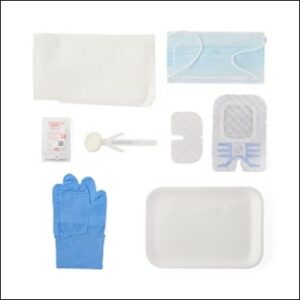CVC Dressing Change Procedure
Dressing changed should be performed about once a week. It will need to be changed sooner if it becomes loose or gets wet or dirty.
The trust will tell you when to shower or bathe after surgery. When you do, make sure the dressings are secure and the catheter site is staying dry. Do not let the catheter site go under water if you are soaking in the bathtub.
Equipment:
- Dressing pack/ Sterile gloves
- Tray
- Nonsterile gloves
- Cleaning solution/cloraprep applicator
- Biopatch- optional
- A clear barrier bandage, such as Tegaderm, IV3000
- Detergent wipes/70% alcohol wipes to clean the tray
Procedure:
- Wash your hands with soap and water. Be sure to wash between your fingers and under your nails. Remove all jewellery from your fingers before washing.
- Dry with a clean paper towel.
- Open dressing pack and set up your supplies on sterile/aseptic surface.
- Put on a pair of clean gloves.
- Gently peel off the old dressing (and Biopatch). Throw away the old dressing and gloves.
- Wash hands/alcohol gel
- Put on a new pair of sterile gloves.
- Check your skin for redness, swelling, or any bleeding or other drainage around the catheter.
- Clean the skin with the sponge and cleaning solution. Air dry after cleaning.
- Place a new Biopatch over the area where the catheter enters your skin. Keep the grid side up and the split ends touching.
- Peel the backing from the clear plastic bandage (Tegaderm or Covaderm) and place it over the catheter.
- Write down the date you changed your dressing.
- Remove the gloves and wash your hands.
Keep all the clamps on your catheter always closed. It is a good idea to change the bionectors when you change your dressing.
Contact the trust if you:
- Have bleeding, redness or swelling at the site.
- Notice leaking, or the catheter is cut or cracked.
- The cuff is exposed.
- Have pain near the site or in your neck, face, chest, or arm.
- Have signs of infection (fever, chills)
- Are short of breath.
- Feel dizzy.
Also contact the provider if your catheter:
- Is coming out of the vein.
- Seems blocked, or you are not able to flush it.

Revised: January 2024
Version: 2 (Review)
Source: Expert Care Manager
 Back
Back